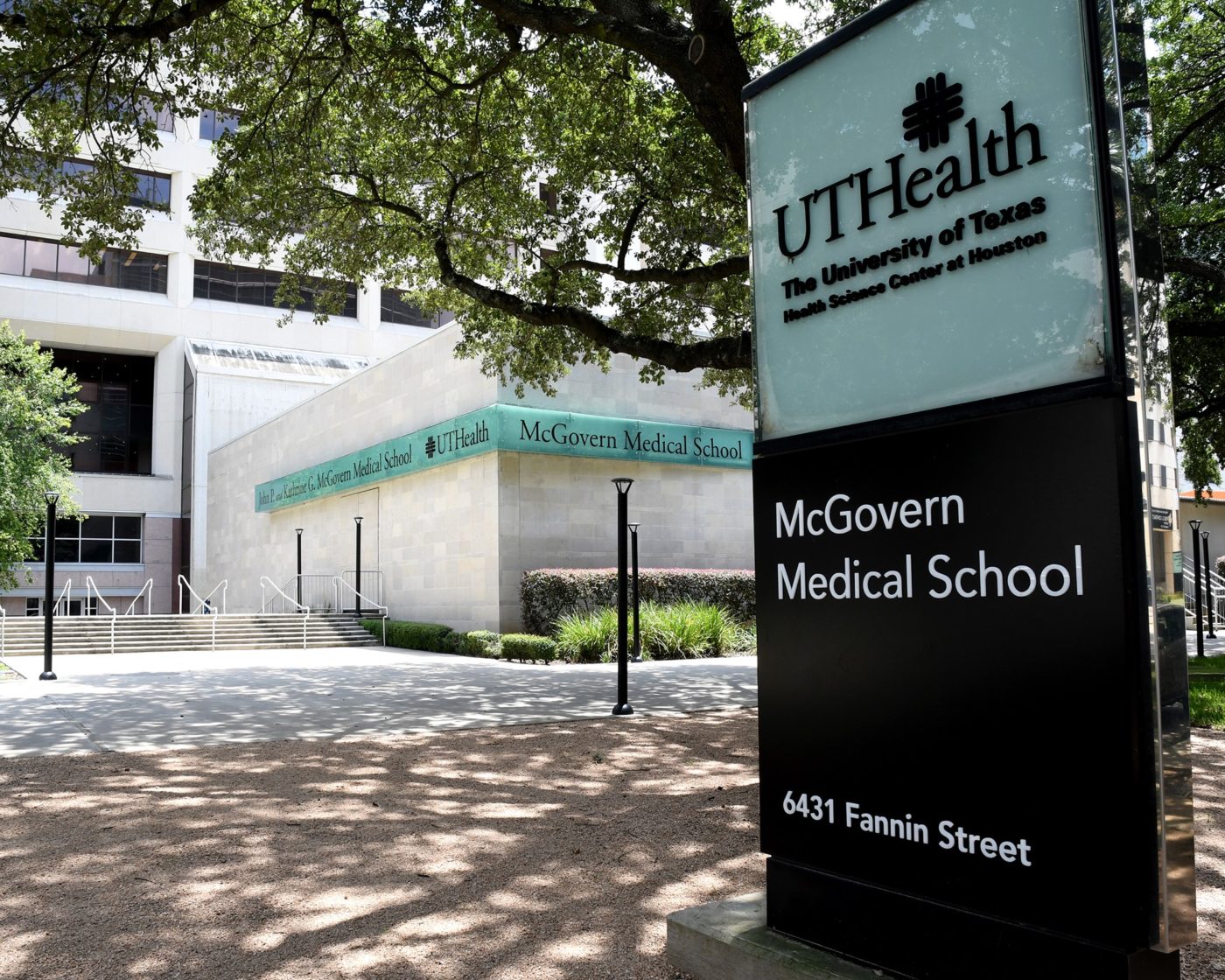Part 1: Introduction
The Joe R. and Teresa Lozano Long School of Medicine at UT Health San Antonio is the largest medical school in South Texas. The Long School of Medicine is accredited by the Liaison Committee on Medical Education (LCME). Each year, 900 students receive their education here and 800 train as residents. UT Health San Antonio is partnered with the University Health System, the military and multiple research partners. Additionally, UT Health San Antonio is a leader in Alzheimer’s and cancer research.
The Long School of Medicine is an excellent place to receive your medical education and training. It’s among the fantastic selection of schools in the state of Texas. If you’re considering going to medical school, you should keep Long School of Medicine on your list.
Why?
That’s what we’ll be explaining in today’s article. In this next guide in our definitive series to medical school applications, we’ll be looking at everything UT Health San Antonio has to offer. We’ll cover…
- Offered programs
- Tuition costs
- Requirements to get in
- Admissions statistics
- Required coursework
- The difference between primary and secondary applications
- Secondary essay prompts with sample essays
- A look at the interview process
- How International Medical Aid can help
Keep reading to learn all about this amazing school and everything it has to offer.
Part 2: Programs Offered at UT Health San Antonio
Long School of Medicine offers the following programs to prospective medical students.
- Doctor of Medicine (M.D.) Degree
- Doctor of Medicine / Master of Public Health Dual Degree
- Doctor of Medicine / Ph.D. Dual Degree
- Residency and Fellowship
Doctor of Medicine
Like most other medical schools, Long School of Medicine offers the traditional Doctor of Medicine (M.D.) degree. This degree is traditionally completed in four years, although some students go through it at an accelerated pace.
The curriculum is divided into three phases:
- Preclinical Curriculum
- Clinical Curriculum
- Simulation Training
Preclinical Curriculum
The preclinical curriculum is also divided into phases. There are Foundational Modules, Longitudinal Modules, and Organ-system Modules.
Foundational Modules:
- Molecules to Medicine (9 credit hours)
- Attack and Defense (9 credit hours)
- Language of Medicine (5.4 credit hours)
Longitudinal Modules:
- Clinical Skills (14.75 credit hours)
- Medicine, Behavior, and Society (6 credit hours)
Organ-system Modules:
- Hematology (3 credit hours)
- Respiratory Health (4 credit hours)
- Renal and Male Reproductive (5 credit hours)
- Circulation (5 credit hours)
- Mind, Brain and Behavior (9 credit hours)
- Endocrine and Female Reproductive (7 credit hours)
- Digestive Health and Nutrition (7 credit hours)
- Form and Function (7.5 credit hours)
Clinical Curriculum
The clinical curriculum is made up of core clerkships and selectives/electives.
Core clerkships consist of…
- Medicine (8 weeks)
- Surgery (8 weeks)
- Family Medicine (6 weeks)
- OB/GYN (6 weeks)
- Pediatrics (6 weeks)
- Psychiatry (6 weeks)
- Emergency Medicine (4 weeks)
- Neurology (4 weeks)
Selectives/electives are made up of…
- 8 weeks of clinical selectives (4 weeks of inpatient sub-internship and 4 weeks ambulatory care)
- 20 weeks of electives (2-4 of these weeks can be taken anywhere in the U.S.
- 4 weeks of mandatory didactics
Simulation Training
UT Health San Antonio provides simulation training to all M.D. candidates through the Center for Clinical Ultrasound and H-E-B Clinical Skills Center. Much like the names suggest, these trainings are designed to simulate the experience of performing ultrasounds and learning clinical skills.
Add up all the credit hours, and you have a traditional, four-year M.D. program on your hands. This program is ideal for anyone who wants to work in a clinical or hospital setting.
Doctor of Medicine / Master of Public Health Dual Degree
The first of the dual-degree options, the Long School of Medicine partners with the UT Health Science Center at Houston School of Public Health in San Antonio to make this happen. This dual degree is ideal for anyone who wants to intersect medicine with public health. This degree equips healthcare providers to better understand their community’s needs outside of the clinical setting.
To apply for this degree, potential students must qualify for both programs: the Long School of Medicine and the School of Public Health.
The M.D./M.P.H. curriculum is versatile, with courses offered online and in-person. The schools share credits, allowing you to graduate faster. You can take the curriculum for each degree separately, taking a total of eight years, or you can choose the five-year track option.
Doctor of Medicine / Ph.D. Dual Degree
The M.D./Ph.D. dual degree is your other option, but it is competitive. Only seven students are admitted each year. If biomedical investigation appeals to you, you might take a deeper look.
There are four specific requirements for the program.
- Pre-clinical Training at Long School of Medicine
- Three years of graduate training and dissertation defense that aligns with the Graduate School of Biomedical Sciences
- Clinical training in which you’re ultimately awarded your M.D. degree
- Integrated MSTP seminars, retreats, workshops and more throughout the program.
Go here for more information.
Residency and Fellowship
Once you’ve completed your M.D. education, it’s time for residency and fellowship. This important part of your training transitions you from the medical school setting into real-world situations as a doctor. You’ll be in clinical and hospital settings during these periods. You’ll be under supervision in the same way that an M.D. or D.O. supervises a P.A., only for a short time. Once you complete residency, you’ll no longer need supervision.
Residency is a wonderful place to be because you get paid. While you won’t be banking millions, this is the part where you start to receive a little bit of what you put in. It’s a really nice feeling.
These are the residencies that UT Health San Antonio offers for M.D. graduates.
- Anesthesiology
- Dermatology
- Diagnostic Radiology
- Emergency Residency
- Family Medicine
- General Surgery
- Internal Medicine
- Interventional Radiology
- Neurological Surgery
- Neurology
- OB/GYN
- Ophthalmology
- Orthopaedic Surgery
- Otolaryngology – Head and Neck Surgery
- Pathology – Anatomical and Clinical
- Pediatrics
- Physical Medicine and Rehabilitation
- Plastic Surgery
- Psychiatry
- Radiation Oncology
- Thoracic Surgery
- Urology
After your residency, you’ll move on to your fellowship. Your fellowship is your time between being a resident and practicing medicine on your own. You’ll work side by side with a physician in your specialty for one to three years before practicing completely on your own.
These are the fellowships that UT Health San Antonio offers.
- Anesthesiology
– Critical Care
– Pain Medicine - Emergency Medicine
– Disaster Medicine
– Education
– Emergency Medical Services
– Emergency Ultrasound
– Global Health
– Global Health / Ultrasound (Combined)
– Wilderness and Survival Medicine - Internal Medicine
– Advanced Drug Development
– Advanced Endoscopy
– Cardiovascular Disease
– Endocrinology, Diabetes, and Metabolism
– Gastroenterology
– Geriatric Medicine
– Hematology and Medical Oncology
– Hospice and Palliative Medicine
– Infectious Diseases
– Interventional Cardiology
– Nephrology
– Pulmonary Disease
– Rheumatology
– Transplant Hepatology - Neurology
– Epilepsy
– Movement Disorders
– Neurophysiology
– Vascular Neurology - Neurosurgery
– Critical Care (CAST)
– Critical Care (UCNS) - Obstetrics and Gynecology (OB/GYN)
– Gynecologic Oncology
– Maternal Fetal Medicine
– Reproductive Endocrinology and Infertility - Ophthalmology
– Oculofacial Surgery
– Retina and Vitreous Surgery - Orthopaedic Surgery
– Foot and Ankle Reproductive Surgery
– Orthopaedic Sports Medicine
– Orthopaedic Trauma
– Shoulder and Elbow - Pathology
– Blood Banking / Transfusion Medicine
– Clinical Informatics
– Cytopathology
– Hematopathology
– Hematopathology Research Year
– Surgical Pathology - Pediatrics
– Critical Care
– Endocrinology
– Hematology / Oncology - Psychiatry
– Child and Adolescent Psychiatry
– Geriatric Psychiatry - Radiology
– Body Imaging / Intervention
– Breast Imaging / Intervention
– CT Imaging
– Emergency Radiology
– Musculoskeletal Radiology
– Neuroradiology
– Women’s Imaging / Entrant
– Body MR Imaging - Surgery
– Trauma Surgery
– Surgical Critical Care
– Vascular Surgery - Urology
– Female Pelvic Medicine and Reconstructive Surgery
– Urologic Oncology
Tuition
In the State of Texas, medical school tuition is subsidized. If you’re a resident attending UT Health San Antonio, your yearly tuition will only be $25,000. But if you’re an out-of-state resident, you’ll fork out over $40,000 per year. If you’re looking at attending a Texas medical school because of the subsidized tuition, you might consider moving to Texas and establishing residency first.
Your tuition costs also cover books and materials, but they don’t cover living expenses. You’ll need to research the San Antonio area where you’ll be living to see how much your living expenses will be. Add that to your tuition total for an accurate estimate of how much each year at Long School of Medicine will cost.
If you need help paying for your medical school education, check out the Loans, Grants, and Scholarships that are available. In some special circumstances, tuition waivers are also available.
Part 3: Requirements to Getting In
So, you know what programs are available through the Long School of Medicine and how much it costs to attend. But what does it take to get in? Click here to see statistics for the incoming classes of 2018, 2019, and 2020. That is the only data that UT Health San Antonio provides.
Required Coursework
The Long School of Medicine requires the following coursework.
- Biological Sciences: 12 credit hours & 2 lab hours
- Biochemistry: 3 credit hours
- General Chemistry: 6 credit hours & 2 lab hours
- Organic Chemistry: 6 credit hours & 2 lab hours
- Physics: 6 credit hours & 2 lab hours
- English: 6 credit hours
- Statistics: 3 credit hours
More detailed information about what courses are accepted to meet these requirements can be found here.
Along with the required coursework, prospective students must take the CASPer exam and submit MCAT scores from within the past five years.
Primary vs. Secondary Applications
If you’re new to the medical school world, you might not have heard about primary and secondary applications. Your primary application will be sent to the Texas Medical and Dental School Application Service (TMDSAS). We wrote a comprehensive article all about TMDSAS. All medical schools located in the state of Texas have access to this medical school application service. It makes the application process much smoother and easier than it might otherwise be.
Your secondary application is the application you’ll send directly to the medical school to which you’re applying. This is where you’ll write your secondary essays and answer questions specific to the school. The great news about the Long School of Medicine is that they don’t require a secondary application for the M.D. program. But before you start shouting for joy, know that this isn’t a common occurrence. You’ll write plenty of secondary essays for other schools. Trust us.
While you won’t have any essays to write for Long School of Medicine, you will have a personal statement to write for your TMDSAS application. Our definitive guide covers the essay portion and what you should expect.
Part 4: Interview Day at Long School of Medicine
First of all, congratulations if you’ve scored an interview with the Long School of Medicine at UT Health San Antonio. This is a big deal! Since there’s no secondary application for Long School of Medicine, more weight rests on your personal statement and the interview. Since you don’t have to write essays for Long, you can focus that time on preparing for your interview.
Before your official interview with Long School of Medicine, you’re invited to complete a Standard One-Way Video Interview (SOWVI). While this is optional, it’s recommended to highlight/showcase you as an applicant. Go here for more details. We highly recommend taking advantage of this opportunity. The more tools you have to stand out as a top applicant, the better.
As for your interview day, you’ll be interviewed on a Friday using the traditional interview format. This means that you’ll have two interviews, each lasting for 30 minutes. You’ll be interviewed by a member of the admissions committee for one interview. The second interview could be the same, or you could be interviewed by administrative staff or a current M.D. candidate.
Your interview will be open file, meaning that your interviewers will have full access to your application. They’ll know who you are and what your grades are before you set foot in the interview room. Be prepared to provide detailed answers about any part of your application. But don’t forget to take a deep breath. Your interviewer is a human being just like you.
Due to the COVID-19 pandemic, you should prepare to interview remotely for a spot at Long School of Medicine. Very few interviews are taking place in person right now. Zoom is the most popular video conferencing tool used for interviews.
Part 5: International Medical Aid
Here at International Medical Aid, we want nothing but the best for you. That’s why we’ve created this series of definitive guides. It’s why we offer medical school admissions consulting. And it’s why we have global internship opportunities.
Our global internship opportunities are perfect for students who are exploring medicine. If you want to see what healthcare is like all over the world, you’ll have the opportunity to shadow medical providers as they treat patients from underserved populations.
We also offer consultation services. Our team at International Medical Aid consists of Johns Hopkins graduates and other medical school experts. We can help with the following.
- Review your TMDSAS application.
- Review your secondary application (for schools that require it)
- Help brainstorm ideas for and review your personal statement
- Conduct a mock interview to prepare for the real deal
- Provide advice for non-traditional students
Go here to schedule an appointment with us. Our online system is easy to navigate. You’ll have an appointment in minutes.
While Long School of Medicine is a great place to earn your education, you should apply to more schools. It’s not a good idea to only apply to one school because there’s no guarantee that you’ll get in. Your chances are much higher if you apply to numerous schools. Don’t overwhelm yourself, but don’t under-apply either. Here is a list of the other schools we’ve covered on the blog.
- Johns Hopkins School of Medicine
- McGovern Medical School at UT Health
- The University of Texas Rio Grande Valley School of Medicine
- UNT Texas College of Osteopathic Medicine
- University of Houston College of Medicine
- Texas A&M College of Medicine
- Johns Hopkins Medical School
- Baylor College of Medicine
- George Washington University School of Medicine
- Vanderbilt University School of Medicine
- St. George’s University School of Medicine
- Lake Erie College of Osteopathic Medicine (in Pennsylvania)
- Sidney Kimmel Medical College at Thomas Jefferson University
- Wake Forest University School of Medicine
- Western University of Health Sciences (in California)
- Drexel University College of Medicine
- Stritch School of Medicine at Loyola University Chicago
- Georgetown University School of Medicine
- Yale School of Medicine
- Perelman School of Medicine
- UCLA Medical School
- NYU Medical School
- Washington University School of Medicine
- Brown Medical School
Conclusion
If you have any questions or need any help along your medical school journey, please don’t hesitate to reach out to us. Helping students like you is what we do. We want to see you succeed. Getting into medical school can be hard, but with the right resources, you’ll be well on your way to success. Medical school admissions consulting can make all the difference. We’ll be here whenever you might need us.






